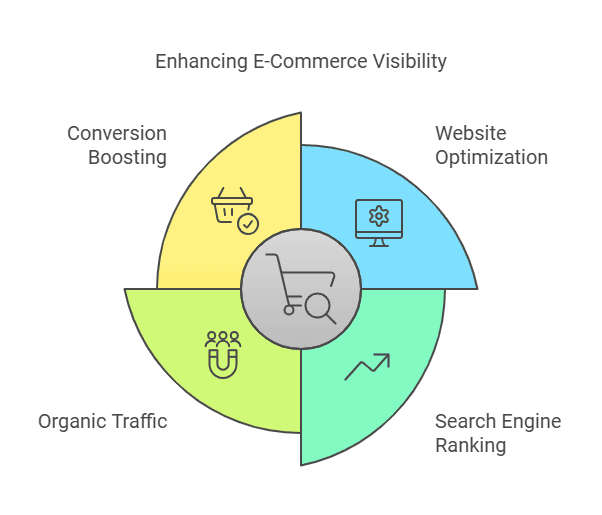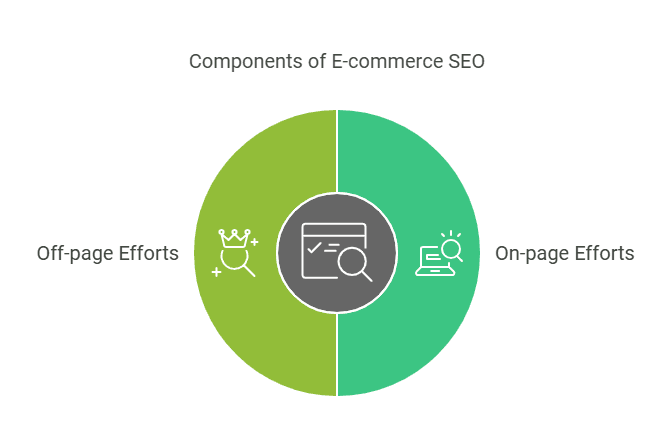E-Commerce SEO: A Comprehensive Guide to Boosting Online Store Visibility and Sales
In today's digital world, e-commerce has experienced significant growth. More consumers are shopping online. Businesses must boost their e-commerce website's visibility to stay competitive. One of the best ways to do this is through e-commerce SEO.
E-commerce SEO optimizes an online store to rank higher in search engines. This drives organic traffic and boosts conversions. This guide will explore e-commerce SEO. It will discuss its importance and ways to boost online stores' visibility and sales.

What is e-commerce SEO?

Key aspects of e-commerce SEO include:
- Product page optimization: ensuring product pages are well-structured, informative, and keyword optimized.
- Site architecture: structuring your website for users and search engines.
- Backlinks: building authoritative links to increase the trustworthiness of your site.
- Technical SEO: It makes the site fast, mobile-friendly, and easy for search engines to crawl.
Why is e-commerce SEO important?
With millions of online stores vying for the same customers, eCommerce SEO can help. It can make your store stand out. Here's where e-commerce SEO is crucial for your business:
- Higher search engine rankings: Optimize your site for SEO. It helps customers find your products in relevant keyword searches.
- Increased organic traffic: SEO boosts site visitors without paid ads. It saves your business money in the long run.
- Better user experience: eCommerce SEO improves site navigation and structure. This enhances the user experience and can increase conversions.
- Cost-effective marketing: organic traffic generated through SEO is free. Unlike periods that require constant investment, SEO results continue to yield long-term benefits.
- Higher conversion rates: An SEO-optimized e-commerce site attracts more interested visitors. This leads to higher conversion rates.
Key e-commerce SEO strategies
E-commerce SEO has many parts. They work together to boost your site's visibility and user experience.
Here are the primary strategies to consider:
1. Keyword research for e-commerce SEO
Effective keyword research is the foundation of any successful SEO strategy. Choosing the right keywords is key. It optimizes your product page for terms that potential customers are searching for.
How to conduct keyword research for eCommerce SEO
- Use tools: leverage keyword research tools like Google Keyword Planner, Ahrefs, Semrush, and Moz to identify high-traffic relevant keywords.
- Focus on long-tail keywords: They are often less competitive. An example is "best-running shoes for women." They can drive traffic that is highly targeted.
- Analyze competitors: research your rivals' websites to find their keywords. Use them to shape your strategy.
Types of keywords for e-commerce SEO
- Product-specific keywords: keywords directly related to your products, like "leather jackets for men."
- Category-specific keywords: keywords related to broader product categories (some, like “women's jackets”).
- Brand keywords: keywords that include brand names or products specific to your brand.
- Transactional keywords: keywords that indicate buying intent (some like “Buy running shoes online").
2. On-Page SEO for E-Commerce
On-page SEO ensures your site's content and structure are optimized for search engines.
Product pages are the core of e-commerce websites, and they need to be fully optimized for SEO.
- Title tags and meta descriptions: create unique, keyword-rich title tags and meta descriptions. Keep them within these limits: Titles: 50-60 characters. Descriptions: 150-160 characters.
- Optimize product descriptions: they must be clear, informative, and rich in keywords. Avoid using manufacturer descriptions to prevent duplicate content.
- Image optimization: I optimized product images. I used descriptive file names and alt text that describe the images. Compress the images for faster loading times.
- Internal linking: Link to related product categories and blog posts on your site. This improves navigation and spreads link equity.
- Product reviews and ratings: customer reviews build trust and improve SEO. Encourage customers to leave reviews and ensure that they appear on the product page.
Category page optimization
Category pages help organize products and can also be a key traffic source.
- Using relevant keywords for a category.
- Including high-quality images and content that highlights the benefits of the product categories.
- Linking to relevant products and subcategories.
3. Technical SEO for e-commerce sites
Technical SEO is vital. It ensures your site runs well and is easily indexed by search engines.
Mobile Optimization
As mobile traffic grows, your e-commerce sites must be mobile-friendly. Google uses mobile-first indexing. It ranks your site based on its mobile version.
- Responsive design: use responsive design so your site adapts to all screen sizes.
- Mobile speed: improve your site's load time on mobile devices. This boosts user experience and rankings.
Site speed optimization
Site speed is a ranking factor for search engines and is crucial for reducing bounce rates. Websites with slow loading times tend to have higher bounce rates, which can harm SEO.
- compressing images and videos.
- minimizing HTTP requests.
- Using a content delivery network (CDN).
- Enabling browser caching.
4. Link Building for E-commerce SEO
To improve your site's rankings, you must build high-quality backlinks. They are vital for boosting your domain authority.
- Guest Posting: Write an article for relevant niche websites. Link to your products and category pages.
- Influencer outreach: work with influencers in your industry. They should link to your website in their content.
- Create link-worthy content: make high-quality blog posts, infographics, or videos that attract backlinks.
E-Commerce SEO Best Practices
- Avoid duplicate content: use canonical tags for similar products in multiple categories.
- Optimize for user experience. Make your site easy to navigate. Use clear calls to action and a smooth checkout process.
- Local SEO: If your business has a physical location, optimize your site for local SEO. Create a Google My Business listing using local keywords and backlinks.
- Rich Snippets: Use schema markup to boost your product listing in search results. It will show extra info like reviews, prices, and availability.
Conclusion: Your Success is Our Goal
E-commerce SEO is an ongoing process. It needs keyword research, page optimization, technical fixes, and link building. Use this guide's strategies to boost your website's visibility, traffic, and conversions.
Investing in SEO will benefit your online store in the long run. It will help you stay competitive and reach more customers. Whether you're a small business or an e-commerce giant, we can boost sales and grow your brand.

